2015 BMW R1200RS First Ride Review
On Day 2 of our little press junket to Ontario, the sun came out, the birds sang, and we rode the new 160-horsepower BMW S1000XR ’til hell wouldn’t have it anymore. Okay, fine, we rode only ’til cocktail hour. On Day 1, though, it rained all day, the mosquitoes made the air hum at every stop, the roads were treacherous and I was very glad to be on the new R1200RS instead.
2015 BMW R1200RS
| Engine | 19.0/20 |
| Suspension/Handling | 13.5/15 |
| Transmission/Clutch | 8.5/10 |
| Brakes | 9.25/10 |
| Instruments/Controls | 4.25/5 |
| Ergonomics/Comfort | 9.25/10 |
| Appearance/Quality | 8.5/10 |
| Desirability | 9.0/10 |
| Value | 9.0/10 |
| Overall Score | 90.25/100 |
2015 BMW S1000XR First Ride Review
If the new XR is a pair of stiletto-heeled red pumps, the new RS is way closer to being your favorite pair of trusted hiking boots. Both bikes now sport advanced electronics that make them nearly foolproof even in sloppy conditions, but for me anyway, there’s something about BMW’s classic Boxer Twin that’s as comforting and reassuring as a home-thawed meal. Maybe it’s because I remember being at the launch of the first oil-head R1100RS a mere 22 years ago.
Though not without their faults (most of which have been cured now that the clutch has been moved to the front of the engine), these things have served us well over the millennia as tourers, sport-tourers and sportbikes, long before we dreamed BMW would ever build anything like the K1600 or S1000RR. The beloved Boxer is what will always pop into my brain when somebody says BMW. There are motorcycles you have a fling with for a couple years who then trade you in for a better rider. Then there are motorcycles you establish a trusting, long-term relationship with. This BMW is one of the latter. The flat-Twin Boxer engine on the new R1200RS is the same DOHC unit that already powers the R1200GS, R1200RT and the new R1200R. BMW claims 125 horsepower at 7750 rpm and 92 lb-ft of torque at 6500 rpm (which worked out to 108.7 rear-wheel hp at 7800 and 77.6 lb-ft at 6600 rpm on the 2015 R1200GS Adventure we dynoed here.) Compared to the engines on the GS, GS Adventure and RT, BMW says the RT should have a bit more low-rev torque thanks to a different airbox.
And with these bikes, it’s all about the torque. If the RS doesn’t have the 160-hp, 11,000-rpm top end of the XR, BMW says the 1170cc Twin at least makes 9 more lb-ft of torque, 92 lb-ft at 6500 rpm instead of the XR’s 83 at 9250. For some reason, the RS feels considerably more substantial at first sit than the XR (must be those two cylinders jutting out), but BMW says the RS is only 18 pounds heavier – 520 to 502. So even though the XR feels way sportier and more hyperactive, the reality is that the RS can probably match it step for step right up to a speed beyond which you should never ride on the public roads anyway. Maybe even down dirt roads, too, since the RS has almost as much suspension travel as the XR – 5.5 inches versus 5.9 at both ends (under a seat whose standard height is 0.8-inch lower, at 32.3 inches).
The new RT is very much like the new R1200R I got to sample last December (when it also rained), the most obvious difference being the addition of a half fairing. Early RS drawings looked a little top-heavy/buxom, but the final design looks really proportional to my eye, and nicely downplays the downdraft intake tracts of the new Boxer that are a little too prominent on the naked, R version.
Instead of the naked bike’s handlebar, the RS gets a pair of clip-ons stuck into a tricky forged deal attached to the top clamp, and instead of the R’s sit-up-straight ergonomics, the RS pulls its rider an inch or two forward and lower into the cockpit, though the footpegs and delicious seat feel like they’re in the same place as before. Where the R is aimed slightly more at urban use, the RS is designed to also serve as an all-weather long-range sport-tourer, to cross over into R1200RT territory.
Originally, the R and RS were supposed to be the same bike, one faired and one not – but BMW can’t ever seem to take the easy route. Specs indicate the RS is 0.5 inch longer of wheelbase, with 0.4-inch less trail than the R, which should give it plenty of high-speed stability along with slightly quicker steering than the R if you’re a he-man willing to leverage its narrower handlebars. (All the manufacturers worry about your body becoming a high-speed source of instability on their naked bikes.) I can vouch for the stability of both of them at medium speeds anyway. Most Boxers feel like they could ghost ride the length of I-70 if you set the cruise control and jumped off.
The base version, which is slated to sell for $14,950, comes with BMW’s Automatic Stability Control, and Rain and Road modes. You’ll need to step up to the Standard package ($16,025) to get the heated grips and cruise control (where I could probably stop). If you want the Dynamic Electronic Suspension Adjustment (ESA), you’ll be signing a $17,770 check. It’s hard to say if the ESA is worth it on this bike, since nobody’s ever seen or ridden the non-ESA one (which is supposed to have a remote preload adjuster and rebound-adjustable shock out back). Shift Assist Pro is a thing I could easily do without on a bike like this one; it’s kind of jerky at low rpm, and low- and mid-rpm is where you ride these bikes most of the time. The six-speed gearbox on every one of these I’ve ridden shifts perfectly without the clutch, up or down, if you roll out of the throttle just the tiniest bit, as God intended, and nudge the lever.
Ride Modes Pro is the other big deal with the Premium package, which gets you Dynamic and customizable User ride modes in addition to Rain and Road, along with Onboard Computer Pro, which allows you to configure the TFT instrument display in various ways to suit your mood. Ho hum … You’re supposed to be able to get Ride Modes Pro as a $350 option on any RS, which is definitely the way to go since with it comes Dynamic Traction Control – a great thing to have in the rain. All RS’s come with switch-offable integral ABS brakes.
Anyway, I wanted all the electronic help I could get in the Canadian slop, and the RS was there for me, complete with two-position heated grips to keep my hands warm (with their own dedicated button), even as the water was making its way up my sleeves by the end of the day (other than that, my Gore-Tex-lined Dainese ensemble proved watertight yet again. Miraculous!).
Grabbing big handfuls of torque in the wet while leaned over results in nothing more alarming than a flashing light on the customizable dashboard, and on the new bike, a quick-turn throttle lets you get to full power with less wristation. Otherwise you just hunker down behind the reasonably generous windshield and get on with it; another advantage of RS over XR for the cheap at heart is that BMW says it’ll get 57 mpg (at a steady 55 mph) versus 44 for the XR. That’ll add up at $4 a gallon for premium.
Okay, yeah, the new S1000XR was the star of the show up there in the Great White North, and as I wrote last week it may be my favorite new BMW. But if I’d had to pick it or the RS to ride back to SoCal from up there in the rain, and live with for the next year or two, I’d have a hard time not climbing aboard the deep-dish, low-stress RS. Something about the old Boxer soothes the soul; it’s probably no coincidence Pirsig’s classic (and interminable) Zen and the Art of Motorcycle Maintenance discusses the Boxer.
+ Highs
- Yo, it’s the Harley-Davidson of Deutschland (but besser)
- One of motorcycling’s all-time great engines; maintain it yourself
- No-stress, smooth operator
– Sighs
- Not the prettiest RS ever
- Instrumentation is a bit busy and small of digit
- The new S1000XR is calling our name…
For a solo rider, the RS (with bags) will do everything the R1200RT will do. For most of us, it’ll do everything we’d reasonably ask of the R1200GS (while being five pounds lighter) – and it’s not at all far removed from the basic standard R1200R, which is one of the best motorcycles for doing absolutely everything else, ever devised. In our profession here at MO, it’s sort of our job to fall for pretty new faces. But the older we get, the more we appreciate true love. Sniff.
2015 BMW R1200RS Specifications | |
|---|---|
| MSRP | base: $14,950, Standard: $16,025, Premium: $17,770 |
| Type | 1170 cc liquid-cooled Boxer Twin |
| Fuel System | EFI |
| Ignition | Electronic |
| Valve Train | DOHC, 4v/ cyl. |
| Horsepower (claimed) | 125 @ 7750 rpm |
| Torque (claimed) | 92 lb-ft @ 6500 rpm |
| Transmission/ Final drive | 6-speed/ shaft |
| Front Suspension | 45mm inverted fork; 5.5-in travel; Dynamic ESA (Electronic Suspension Adjustment) optional |
| Rear Suspension | Single shock; adjustable rebound damping and remote preload adjustment; 5.5-in travel; Dynamic ESA optional |
| Front Brake | Dual 320mm discs; 4-piston calipers, part-integral ABS (can be switched off) |
| Rear Brake | 276mm disc; 2-piston caliper, ABS |
| Front Tire | 120/70ZR-17 radial |
| Rear Tire | 180/55ZR-17 radial |
| Wheelbase | 60.2 in. |
| Rake/trail | 27.7 deg./ 4.5 in. (114mm) |
| Seat Height | 32. in., Standard. |
| Curb Weight (per BMW) | 520 lb. |
| Fuel Capacity | 4.7 gal. |
| Tested Fuel Economy | NA (BMW claims 57 mpg @ 56 mph) |
| Available Colors | Racing Red, Light White |
| Warranty | 24 months |
More by John Burns



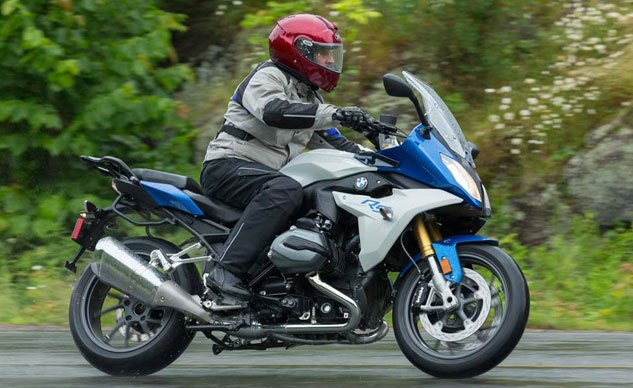
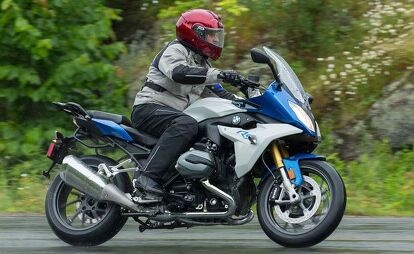

































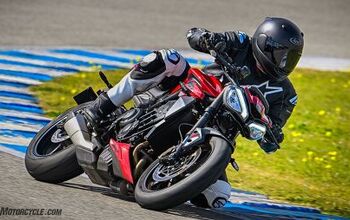
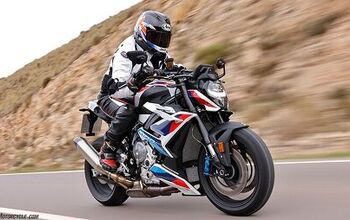
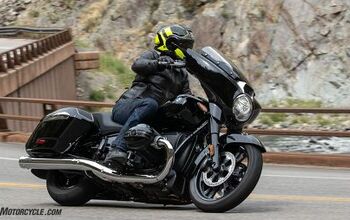









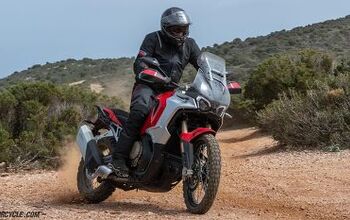

Comments
Join the conversation
Pirsig rode a Honda CB77, his friend that's with him in the first half of the book was on the boxer
I think I'm the demographic that you're looking for. I I'm in love.